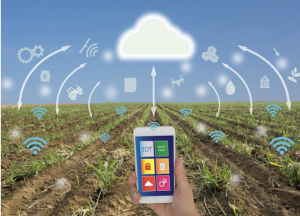Beef prices are projected to continue increasing as U.S. beef production declines with no signs of a cattle herd rebuild. Additionally, cheap beef may soon become further out of reach…
Research Shows the Profile of Brazilian Digital Agriculture During the Pandemic
An unprecedented survey carried out by the Brazilian Agricultural Research Corporation (Embrapa) reveals the behavior around the use of digital solutions in the field in Brazil during of the Covid-19 pandemic. The research conducted in partnership with the Brazilian Micro and Small Business Support Service (Sebrae) and the National Institute for Space Research (Inpe) revealed that 84% of Brazilian farmers use at least one digital technology as a support tool in agricultural production. The survey applied through online questionnaires was answered between April and June this year and was attended by 753 people from all Brazilian states – 504 farmers and 249 digital agriculture companies.
Conexão na lavoura: pesquisa mostra como está a agricultura digital no Brasil. #AgênciaEmbrapa #AgriculturaDigital https://t.co/3AvYCf9lZf
— Embrapa (@embrapa) August 10, 2020
According to the research, the use of the internet to search information related to field activities is the most used tool (70.4%). After, it is cell phone applications (such as Facebook and WhatsApp) or computer programs to promote production (57.5%), cell phone applications or computer programs for farmer management (22.2%), global satellite positioning systems (20.4%), and data or images generated by remote sensors – satellite and drones (17.5%). According to researcher at Embrapa Informática Agropecuária Édson Bolfe, who coordinated the study, these tools are used in general activities with the aim of helping in the planning and management of the farm:
“It was also possible to observe that a good part of the producers already use other applications from remote and field sensors, embedded electronics, applications or digital platforms for specific purposes,” explained Édson Bolfe, in interview at the Embrapa website.
The main functions of digital technologies used by Brazilian farmers are to obtain information on the activities of the farm (66.1%); for farm management (43.3%); for purchase and sales of inputs and production (40.5%); for mapping land use (32.7%); and for the prediction of climatic risks (30.2%).
A Globo Rural story about the results of research shows that before the pandemic it was common for farmers to wait for the seller on the farm. Currently, with social distance, the business started to be done online. Besides, direct consumer sales have also increased in recent months, especially in fruits and vegetables, the story says.
Falta de conhecimento especializado é outro fator de dificuldade apontado por agricultores em estudo feito por Embrapa, Sebrae e Inpe. Confira resultados da #pesquisa inédita divulgados em primeira mão pela @Globo_Ruralhttps://t.co/yZztbeWlMA
— Globo Rural (@Globo_Rural) August 6, 2020
The research also reveals the difficulties of farmers to adopt digital farming tools. The first is the investment cost for the acquisition of machines, equipment or applications (67.1%); second the problems or lack of internet connection in rural areas (47.8%); third the cost for hiring specialized service providers (44%); and fourth the lack of knowledge about which technologies are most appropriate (40.9%):
“The use of digital technologies in agriculture in Brazil is not greater due to the lack of information and technical guidance, especially among small and medium farmers”, said Victor Ferreira, Agribusiness analyst at Sebrae, in an interview to Globo Rural magazine.
In the same story, the researcher’s Inpe Ieda Sanches said she constantly receives contacts in search of professionals who understand remote sensing and agriculture, for example:
“We have images of high-quality satellites and processing platforms, all free, which can be used for agricultural analysis. But for that, human resources are needed,” she says.

The Canal Rural website reported that in the opinion of the researchers the advantages of using digital tools in agriculture are increased productivity, greater labor efficiency, higher production quality, reduced environmental impact and optimization in the use of inputs in general. Meanwhile, the use of applications and web services enables better planning of daily activities, cost reduction and increased profit, in addition to the purchase of inputs and marketing of products. The Canal Rural website also highlights that the cost of digital technologies scares 67% of producers.
In addition to the behavior of farmers, the survey also included the participation of 249 companies and service providers. The main digital technologies offered by companies are cell phone applications or computer programs to disseminate production information (62.2%); internet supply for activities related to production (61.4%); services in global satellite positioning systems – GPS on the farms (40.6%); data or images generated by remote sensors – satellites and drones (36.9%); and data or images about plants, animals, soil, water, climate, diseases or pests provided by field sensors (31.3%).
According to research from Embrapa, the limitations for companies are associated with problems or lack of internet in rural areas (61.4%); investment cost in machinery and equipment by farmers (58.2%); supply of qualified and specialized external labor (49%); training in digital agriculture technologies (47.4%); and cost for the producer to hire service providers (43%).
The main customers of digital agriculture companies are producers (73.9%); followed by associations, cooperatives or NGOs (51.8%); meat producers (45.8%); other service providers (33.3%); and municipal, state or federal public agents (29.3%).
The results of the study will be used to help guide new research and innovations in addition to supporting market strategies.





